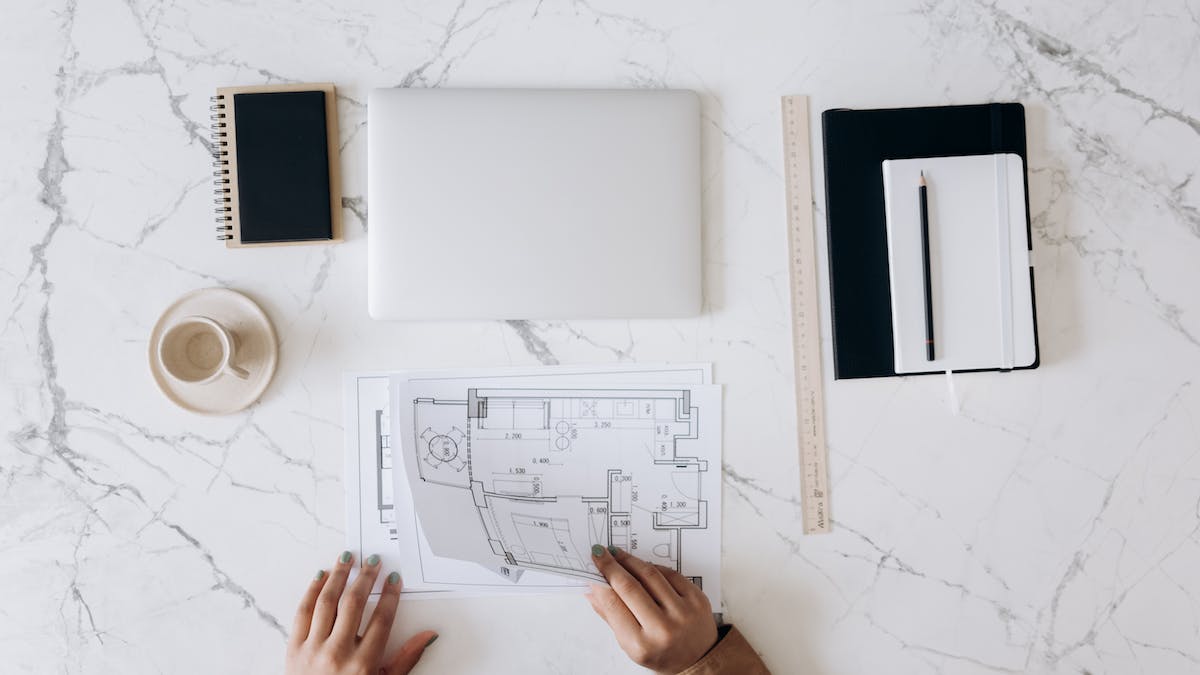Best laptops for architects | Architects are the masterminds behind the structures that shape our world, from soaring skyscrapers to cozy cafes. Their work demands creativity, precision, and cutting-edge technology. That’s where the right laptop comes in. It’s not just a tool for checking emails and browsing the web; it’s a powerful workstation that can handle demanding design software, render 3D models with ease, and keep you productive on the go.
But with so many laptops on the market, how do you choose the best one for your needs? Don’t worry, we’ve got you covered. In this guide, we’ll break down the essential factors to consider when buying a laptop for architecture, from processing power and graphics to display quality and portability. We’ll also highlight some of the top laptops on the market that are perfect for architects, so you can find the perfect one to help you bring your vision to life.
So, whether you’re a seasoned architect or a student just starting out, read on to find the best laptop to take your career to the next level.
Laptop Requirements for Architects
- Processor: Intel Core i7 or AMD Ryzen 7 (or higher)
- RAM: 16GB (or more)
- Graphics card: Dedicated NVIDIA RTX 3050 or AMD Radeon RX 6600 (or better)
- Storage: 512GB SSD (or more)
- Display: 15.6-inch Full HD (or larger)
Best Laptops for Architects
- Apple 2023 MacBook Pro Laptop M3 Pro chip ($2,399)
- MSI Creator Z17 HX Studio Laptop ($3,814)
- Dell Newest XPS 9710 Business Laptop ($1,599)
- ASUS Creator Laptop Q530 ($1,309)
- Acer Nitro 5 AN515-58-57Y8 Gaming Laptop ($770)
- HP 2023 Newest Envy Laptop ($1,184)
1. MacBook Pro (Best laptop for architects 2024)

| Model Name | MacBook Pro |
| Screen Size | 16.2 Inches |
| Hard Disk Size | 512 GB |
| Ram Memory Installed Size | 18 GB |
| Operating System | Mac OS |
| Graphics Card Description | Integrated |
| Graphics Coprocessor | Apple Integrated Graphics |
The MacBook Pro with the M3 Pro or M3 Max chip offers a compelling choice for architects due to its powerful specifications and features tailored for demanding design workflows. Here are some key points that make it a strong contender among the best laptops for architects:
Properties of MacBook Pro
- Exceptional Performance: The M3 Pro chip, boasting a 12-core CPU and 18-core GPU (or the M3 Max with up to a 16-core CPU and 40-core GPU), ensures remarkable performance. Architects dealing with resource-intensive tasks like rendering 3D content or developing complex models will benefit from the laptop’s processing capabilities.
- Extended Battery Life: With up to 22 hours of battery life, architects can work on the go without constantly worrying about running out of power. The power-efficient design of Apple silicon ensures consistent performance whether the laptop is running on battery or plugged in.
- Brilliant Pro Display: The 16.2-inch Liquid Retina XDR display, featuring Extreme Dynamic Range and high brightness levels, provides a stunning visual experience. Architects can manipulate detailed designs with precision, thanks to the display’s clarity and color accuracy.
- Compatibility with Professional Software: The MacBook Pro is fully compatible with a range of professional applications critical for architects, including Adobe Creative Cloud, Apple Xcode, and other design tools. This ensures a seamless and efficient workflow for architectural projects.
- Advanced Camera and Audio: The 1080p FaceTime HD camera, three-mic array, and six-speaker sound system with Spatial Audio enhance the laptop’s capabilities for virtual meetings, presentations, and collaborative discussions, which are essential aspects of an architect’s work.
- Versatile Connectivity Options: The MacBook Pro offers a variety of ports, including Thunderbolt 4, HDMI, SDXC card slot, and a headphone jack. This facilitates easy connectivity to external devices, additional displays, and other peripherals, supporting the diverse needs of architects.
- Magic Keyboard with Touch ID: The backlit Magic Keyboard with a full-height function key row and Touch ID provides a comfortable and secure typing experience. It streamlines access to the laptop and authentication for enhanced security.
- Apple Ecosystem Integration: Architects can leverage the seamless integration with other Apple devices, enhancing productivity by easily sharing content between devices and using the MacBook Pro for FaceTime calls or messaging.
- Built to Last: The durable all-aluminum unibody enclosure and regular free software updates contribute to the longevity of the MacBook Pro, ensuring that it remains a reliable tool for architectural professionals over the years.
In conclusion, the MacBook Pro with M3 Pro or M3 Max is an excellent choice for architects seeking a high-performance, reliable, and feature-rich laptop that can handle the complexities of architectural design and visualization.
2. MSI Creator Z17 HX Studio Laptop
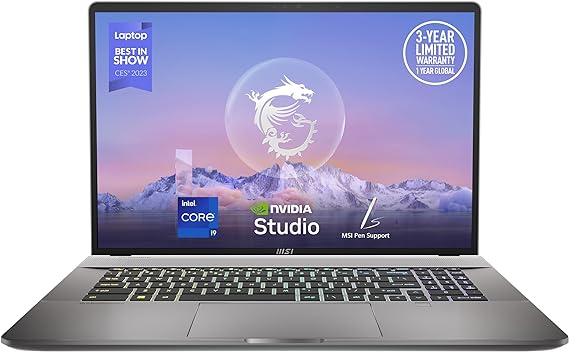
| Model Name | Creator Z17HXStudio A13VGT-065US |
| Screen Size | 17 Inches |
| Color | Lunar Gray |
| Hard Disk Size | 2 TB |
| CPU Model | Core i9 |
| Ram Memory Installed Size | 64 GB |
| Operating System | Windows 11 Pro |
| Special Feature | Pen |
| Graphics Card Description | GeForce RTX 4070 Dedicated |
The MSI Creator Z17 HX Studio Laptop appears to be a strong contender for architects due to its powerful specifications and features tailored to demanding tasks like design, rendering, and multitasking. Here are several aspects that make it a good choice for architects:
Properties of Creator Z17 HX
- 13th Gen. Intel Core i9 Processor: The inclusion of a high-performance 13th Gen. Intel Core i9 processor ensures that architects can handle resource-intensive tasks such as 3D modeling, rendering, and complex design software with ease. This processor provides the necessary power for a seamless and responsive experience.
- Windows 11 Pro: The laptop comes with Windows 11 Pro, offering enhanced performance and features that can benefit professionals. The intuitive navigation and faster performance make it well-suited for multitasking work, which is essential for architects who often need to run multiple design applications simultaneously.
- QHD+ Display with 165Hz Refresh Rate: The 17″ QHD+ display with a 16:10 aspect ratio and 165Hz refresh rate is well-suited for architectural work. The higher resolution and color accuracy (100% DCI-P3) provide architects with a detailed and vibrant visual experience, crucial for tasks like editing and reviewing intricate designs.
- Flip-n-Share Design: The 180° lay-flat design and ultra-thin bezels enhance collaboration among architects. This feature makes it easy to share ideas and designs with co-workers, fostering uninterrupted communication and collaboration during group discussions or presentations.
- Cooler Boost 5 Technology: Architects often engage in resource-intensive tasks that generate heat. The Cooler Boost 5 technology ensures optimal thermal dissipation, preventing overheating during prolonged usage. This is essential for maintaining consistent performance and prolonging the laptop’s lifespan.
- Maximized Screen Real Estate: The ultra-thin bezels maximize screen real estate, providing architects with ample space to work on complex designs. The 16:10 aspect ratio is particularly beneficial for architectural applications, offering a more spacious canvas for drafting and designing.
In summary, the MSI Creator Z17 HX Studio Laptop combines a powerful processor, high-resolution display, collaborative design features, and effective cooling technology, making it a solid choice for architects who require a high-performance machine for their demanding design and rendering tasks.
3. XPS 9710 (Best Dell laptop for architects)
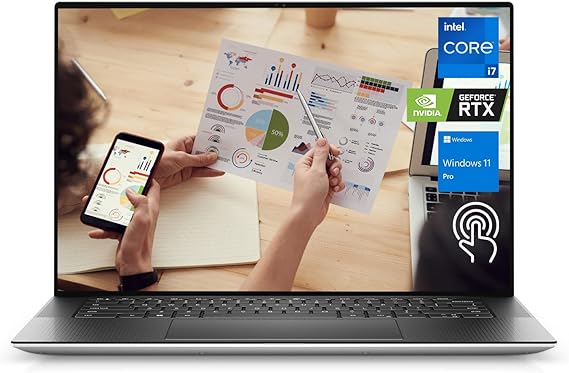
| Model Name | XPS 9710 |
| Screen Size | 17 Inches |
| Color | Silver |
| Hard Disk Size | 1 TB |
| CPU Model | Core i7 Family |
| Ram Memory Installed Size | 32 GB |
| Operating System | Windows 11 Pro |
| Special Feature | Backlit Kb |
| Graphics Card Description | GeForce RTX 3060 Dedicated |
The Dell XPS 9710 Business Laptop appears to be an excellent choice for architects due to several key features that cater to their specific needs:
Properties of XPS 9710
- High-Performance Configuration: The laptop is equipped with an Intel Core i7-11800H processor, featuring 8 cores and 16 threads. This powerful CPU, combined with a high-speed 32GB DDR4 RAM, ensures smooth multitasking capabilities, which is crucial for architects working with resource-intensive design software.
- Graphics Capabilities: The inclusion of an NVIDIA GeForce RTX 3060 with 6GB VRAM provides robust graphics performance. This is essential for architects who often work with complex 3D models and rendering tasks, ensuring a seamless and efficient design process.
- Ample Storage and Fast Data Access: The 1TB PCIe Solid State Drive not only offers substantial storage space but also ensures quick data access. Architects dealing with large project files and high-resolution visuals will benefit from the speed and responsiveness provided by the SSD.
- High-Resolution InfinityEdge Touch Display: The 17.0″ UHD+ InfinityEdge display with a resolution of 3840 x 2400 provides a stunning visual experience. Architects can appreciate the fine details of their designs, enhancing the accuracy and precision of their work.
- Connectivity Options: The laptop’s connectivity options, including 4 x Thunderbolt 4 ports and a full-size SD card reader, are advantageous for architects who often need to transfer large files or connect to external devices such as drawing tablets and high-resolution monitors.
- Portability and Security: Despite its powerful features, the laptop remains relatively portable, allowing architects to work on-the-go. The inclusion of a fingerprint reader adds an extra layer of security, crucial for protecting sensitive architectural designs.
- Optimized for Windows 11 Pro: The operating system, Windows 11 Pro, provides architects with an organized and intuitive workspace, helping them optimize productivity. Enhanced collaboration features can also facilitate teamwork, which is often essential in architectural projects.
In summary, the Dell XPS 9710 combines powerful hardware, a high-resolution display, and a range of connectivity options, making it an ideal choice for architects who demand performance, reliability, and versatility in their professional laptops.
4. Creator Q530 (Best Asus laptop for architects)

| Model Name | Creator Laptop Q |
| Screen Size | 15.6 Inches |
| Color | Black |
| Hard Disk Size | 1 TB |
| CPU Model | Core i7 Family |
| Ram Memory Installed Size | 32 GB |
| Operating System | Windows 11 Pro |
| Graphics Card Description | NVIDIA GeForce RTX 3050 Dedicated |
The ASUS Creator Laptop Q530 offers a comprehensive set of features that make it an excellent choice for architects:
Properties of Creator Q530
- Powerful Processor: The 13th Generation Intel Core i7-13620H 10-Core processor provides ample power for handling complex architectural software and multitasking efficiently.
- Ample Memory: With 32GB DDR5 SDRAM clocked at 4800 MHz, architects can run multiple design software simultaneously without experiencing slowdowns or bottlenecks.
- Fast Storage: The 1TB NVMe M.2 Solid State Drive ensures swift boot times and quick access to large design files, allowing architects to work seamlessly.
- High-Resolution OLED Display: The 15.6″ FHD OLED Display with 600 nits brightness and 100% DCI-P3 color gamut delivers crisp, accurate visuals, ideal for reviewing detailed architectural drawings and renderings.
- Graphics Performance: The NVIDIA GeForce RTX 3050 GPU with 6GB GDDR6 memory provides ample graphics power for rendering complex 3D models and visualizations.
- Connectivity Options: A variety of ports including Thunderbolt 4, USB 3.2 Gen 2, HDMI v2.1, and LAN ensure compatibility with external displays, peripherals, and networking equipment.
- Portability: Despite its powerful hardware, the laptop remains relatively lightweight at 3.97 lbs and boasts a sleek design, making it convenient for architects to carry between job sites or meetings.
- Long Battery Life: The 90Whr battery offers up to 8 hours of non-gaming battery life, providing architects with extended productivity without needing to constantly search for power outlets.
- Additional Features: The inclusion of a full-size backlit keyboard with a fingerprint reader, along with a 3DNR FHD webcam and integrated microphone, enhances usability and security for architects working remotely or collaborating with clients.
Overall, the ASUS Creator Laptop Q530 combines robust performance, stunning display quality, and versatile connectivity options, making it an excellent choice for architects who demand power and flexibility in their computing devices.
5. Acer Nitro 5 (Best gaming laptop for architects)
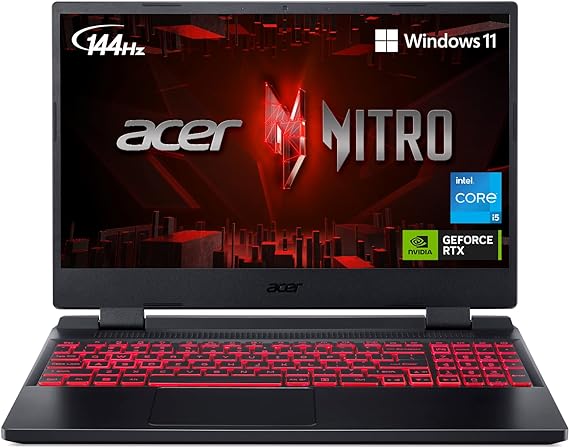
| Model Name | AN515-58-57Y8 |
| Screen Size | 15.6 Inches |
| Color | Black |
| Hard Disk Size | 512 GB |
| CPU Model | Core i5 |
| Ram Memory Installed Size | 16 GB |
| Operating System | Windows 11 Home |
| Special Feature | Backlit Keyboard |
| Graphics Card Description | NVIDIA GeForce RTX 3050 Dedicated |
The Acer Nitro 5 with its robust specifications presents itself as a strong contender for architects looking for a reliable and powerful laptop. Here’s why it’s a good choice:
Properties of Acer Nitro 5
- Performance: The 12th Gen Intel Core i5 processor coupled with 16GB DDR4 RAM ensures smooth multitasking and handling of resource-intensive architectural software like AutoCAD, Revit, or SketchUp.
- Graphics Capabilities: The NVIDIA GeForce RTX 3050 Ti graphics card with 4GB dedicated GDDR6 VRAM brings ray tracing capabilities and supports DirectX 12 Ultimate, crucial for architects working with 3D rendering and visualization tasks.
- Display Quality: Architects rely heavily on accurate and vibrant displays for detailed designs. The 15.6” Full HD IPS display with a 144Hz refresh rate delivers crisp visuals, ensuring precision in design work.
- Storage and Expandability: The 512GB PCIe Gen 4 SSD provides ample storage for large architectural files and software installations. Additionally, the provision for expanding storage through PCIe M.2 slots and a 2.5″ hard drive bay allows for future scalability.
- Connectivity: Killer Ethernet E2600 and Killer Wi-Fi 6 AX1650 ensure stable and high-speed internet connectivity, essential for collaborating with teams or accessing cloud-based resources. The array of USB ports, including Thunderbolt 4, offers versatility in connecting external devices.
- Cooling System: Architects often engage in prolonged work sessions, making efficient cooling crucial to prevent thermal throttling. The dual-fan cooling system with quad-exhaust port design ensures optimal thermal management, maintaining performance during extended usage.
- Portability: Despite its powerful hardware, the Acer Nitro 5 maintains a relatively compact form factor, making it suitable for architects who need to work on the go. Its dimensions and weight make it easy to carry between job sites or client meetings.
- Warranty: The inclusion of a one-year international travelers limited warranty provides peace of mind for architects who may need support while traveling or working abroad.
In summary, the Acer Nitro 5 offers a well-rounded package of performance, graphics capabilities, display quality, connectivity options, and portability, making it an excellent choice for architects needing a versatile and powerful laptop for their design work.
6. HP 2023 Newest Envy Laptop
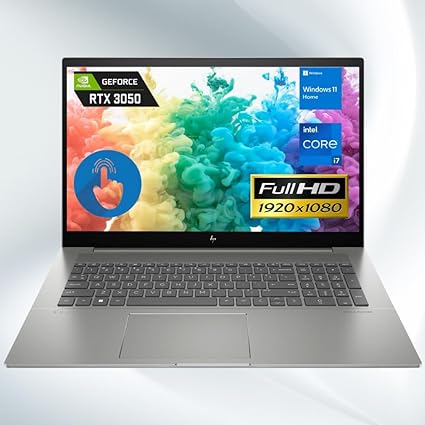
| Model Name | TPN-C160 |
| Screen Size | 17.3 Inches |
| Color | Gray |
| Hard Disk Size | 1 TB |
| CPU Model | Core i7 Family |
| Ram Memory Installed Size | 64 GB |
| Operating System | Windows 11 Home |
| Special Feature | Backlit Kb |
| Graphics Card Description | NVIDIA RTX 3050 Dedicated |
The HP Envy laptop with the specified features is an excellent choice for architects due to several key factors:
Properties of HP Envy
- High-Speed RAM and Enormous Storage: The 64GB high-bandwidth DDR4 RAM ensures that architects can smoothly run demanding applications like AutoCAD, Revit, and other 3D modeling software alongside multiple browser tabs and other programs. The 1TB PCIe NVMe M.2 Solid State Drive provides ample storage for large project files and quick access to data, enhancing overall productivity.
- Powerful Processor: The 13th Gen Intel Core i7-1355U Processor, with its 10 cores and 12 threads, delivers robust performance. Its high clock speed, which can reach up to 5.0 GHz, is crucial for handling complex computations and rendering tasks quickly, making it ideal for architecture software that requires significant processing power.
- Large FHD Touchscreen Display: The 17.3″ diagonal, FHD touchscreen (1920 x 1080) offers a large and vibrant workspace, which is essential for detailed design work. The touch functionality can be particularly useful for architects who prefer intuitive navigation and drawing directly on the screen.
- Comprehensive Connectivity Options: With 3 x USB 3.2 Type-A ports, 2 x Thunderbolt 4 ports, 1 x HDMI 2.1 port, a headphone/microphone combo, and an SD card reader, this laptop provides extensive connectivity options. These are crucial for architects who need to connect multiple peripherals, external displays, and transfer data quickly from various sources.
- Additional Features: The backlit keyboard allows for comfortable use in low-light environments, and the built-in webcam supports virtual meetings and presentations, which are increasingly common in modern architectural practices. Wi-Fi 6 ensures fast and reliable internet connectivity, which is essential for collaboration and accessing cloud-based resources.
- Operating System: Windows 11 Home offers a user-friendly interface with improved performance features and better multi-monitor functionality, which can be very beneficial for architects who often use multiple displays. The compatibility with Android apps can also be an advantage for those who use mobile apps in their workflow.
Overall, the combination of high-performance components, a large and responsive display, extensive connectivity options, and advanced operating system features makes this HP Envy laptop a powerful tool for architects, enhancing their ability to work efficiently and creatively.
Conclusion – Best Laptops for Architects
Choosing the best laptop for an architect is akin to picking the perfect brush – it depends on their individual style and needs. Whether you prioritize raw processing power for demanding 3D modeling, a vibrant display for visualizing your masterpieces, or portability for on-site sketching, there’s a laptop out there waiting to unleash your creativity. So, research thoroughly, consider your workflow, and invest in a machine that empowers you to translate your architectural vision into stunning reality. Remember, the ideal laptop is an extension of your artistic expression, ready to collaborate on every step of your journey from conception to construction. Now go forth and build!
FAQs – Best Laptops for Architects
Architects, rejoice! Wrangling demanding software, portable power, and eye-catching displays? This FAQ lays bare the secrets to finding the perfect laptop for your craft. Say goodbye to tech jargon, say hello to clear answers and top picks, from processors to pixels. Ready to build your workstation on the go? Dive in!
In this section, we will look for answers to the following frequently asked questions about laptops for Architects.
- What is the best laptop for architects in 2024?
- What laptop specs do architects need?
- What is the best MacBook for architects in 2024?
- Is Windows or Mac better for Architecture?
- Is Apple laptop good for architects?
- How much RAM should an architect have?
1. What is the best laptop for architects in 2024?
The best laptop for architects depends on their specific needs, budget, and preferences. Architects typically require powerful laptops with sufficient processing power, graphics capabilities, and memory to handle demanding tasks such as 3D modeling, rendering, and running architectural software. Here are some factors to consider when choosing a laptop for architecture:
- Performance:
- Look for a laptop with a powerful multi-core processor (Intel Core i7 or equivalent AMD Ryzen).
- Consider a laptop with dedicated graphics, preferably from NVIDIA or AMD, for better performance in 3D modeling and rendering.
- RAM:
- Aim for at least 16GB of RAM, but 32GB or more is preferable for handling large architectural projects and multitasking.
- Graphics Card:
- A dedicated graphics card with sufficient VRAM is important for handling complex 3D models and rendering. NVIDIA Quadro or GeForce RTX series and AMD Radeon Pro series are popular choices.
- Storage:
- Consider a laptop with a fast SSD (Solid State Drive) for quick boot times and faster data access.
- Display:
- A high-resolution display with accurate color reproduction is essential for working with architectural drawings and designs. A laptop with a minimum of Full HD (1920×1080) resolution is recommended.
- Portability:
- Depending on your work style, consider the weight and size of the laptop. A portable laptop may be beneficial for architects who need to work on the go.
- Build Quality:
- Choose a laptop with a durable build and a comfortable keyboard for long hours of work.
- Compatibility:
- Ensure that the laptop is compatible with the architectural software you use, such as AutoCAD, Revit, Rhino, or other design and rendering tools.
- Battery Life:
- A laptop with good battery life is important, especially if you need to work away from power outlets.
2. What laptop specs do architects need?
Choosing the right laptop specs for architects depends on the specific software they use and the complexity of their projects. However, some general recommendations can help you navigate the options:
Essential Specs:
- Processor (CPU): Intel Core i7 or i9, or AMD Ryzen 7 or 9. These powerful processors can handle demanding architecture software like Revit, ArchiCAD, and SketchUp.
- RAM: 16GB minimum, 32GB or more recommended. More RAM allows you to run multiple programs simultaneously without lag.
- Storage: 500GB SSD minimum, 1TB or more preferred. SSDs offer significantly faster boot times and file loading compared to traditional hard drives.
- Graphics Card (GPU): Dedicated graphics card with at least 4GB of VRAM is crucial. Opt for NVIDIA RTX or AMD Radeon cards for optimal performance with 3D rendering and modelling.
- Display: Full HD (1920×1080) resolution is good, but consider a higher resolution (like QHD or 4K) for sharper details and larger workspaces. Look for color accuracy if working with presentations or graphic design.
Additional Considerations:
- Operating System: Windows 10 or later is preferred for most architecture software compatibility. Some programs might offer versions for macOS, so check your specific needs.
- Battery Life: Look for laptops with good battery life if you work on the go, ideally 8 hours or more.
- Portability: Choose a laptop size and weight that suits your needs. Consider a smaller and lighter laptop if you travel frequently, but prioritize a larger screen and powerful specs for intensive work.
- Durability: Architects might benefit from a rugged laptop with a sturdy build and spill-resistant keyboard.
- Connectivity: Ensure the laptop has enough USB ports and SD card reader for peripherals and external storage. Wi-Fi 6 or Thunderbolt 4 is ideal for fast internet connections and data transfers.
Here are some additional tips:
- Research the software requirements: Check the recommended specs for the specific software you’ll be using to ensure your laptop can handle it.
- Consider future needs: Choose a laptop that can grow with your skills and project demands.
- Don’t be afraid to ask for help: If you’re unsure about your needs, consult with tech professionals or other architects for recommendations.
Remember, the ideal laptop specs for architects can vary depending on individual needs and budget. Don’t hesitate to adjust these recommendations based on your specific workflow and software preferences.
3. What is the best MacBook for architects in 2024?
The “best” MacBook for architects depends on your specific needs and budget, but there are two top contenders:
1. MacBook Pro 16-inch (2023 M2): This is the current powerhouse of the MacBook lineup and a solid choice for most architects. It boasts a stunning Liquid Retina XDR display with exceptional color accuracy, perfect for detailed architectural renderings. The M2 Pro and M2 Max chips offer blazing-fast performance for demanding architectural software like AutoCAD, Revit, and SketchUp. You can also configure it with up to 8TB of SSD storage, ideal for storing large project files. However, it’s also the most expensive option, starting at $2,499.
2. MacBook Air M2 (2022): This is a more budget-friendly option, starting at $1,099, and still a great choice for architects on the go. The M2 chip delivers impressive performance for everyday tasks and light architectural work. The Air’s thinner and lighter design makes it highly portable, perfect for carrying to client meetings or construction sites. However, its smaller screen and lower resolution might not be ideal for detailed work, and its fanless design might struggle with sustained heavy workloads.
Here are some additional factors to consider:
- Software compatibility: Make sure your chosen MacBook can run the software you need, as some architectural programs might not be compatible with macOS.
- Storage: Consider how much storage you’ll need for project files and software. 512GB is a good starting point, but you might need more depending on your needs.
- RAM: 16GB RAM is recommended for most architects, especially if you’ll be working with large files or multiple applications simultaneously.
- Battery life: If you’re often on the go, consider a MacBook with good battery life, like the MacBook Air M2 which can last up to 15 hours on a single charge.
Ultimately, the best MacBook for you will depend on your specific needs and budget. We recommend trying out both models in a store, if possible, to see which one feels more comfortable and suits your workflow better.
4. Is Windows or Mac better for Architecture?
Both Windows and Macs have their pros and cons for architects, and the “better” choice depends on your specific needs and priorities. Here’s a breakdown to help you decide:
Software compatibility:
- Windows: Most traditional architecture software, like AutoCAD, Revit, and ArchiCAD, are primarily developed for Windows. You’ll have the widest software compatibility and choice.
- Mac: Macs are gaining ground in software compatibility, but some niche programs or older versions might not be available. Many popular programs like SketchUp, Rhino, and Lumion run well on both platforms.
Hardware and performance:
- Windows: You have a wider range of hardware options at various price points, allowing you to build a powerful workstation or find a more budget-friendly laptop. Upgrading components is generally easier and cheaper.
- Mac: Macs are known for their sleek design and premium build quality, but they tend to be more expensive for similar performance compared to Windows machines. Upgrading components is usually not possible.
User experience and workflow:
- Windows: Windows offers a familiar interface for many users and extensive customization options. However, navigating through menus and settings can sometimes feel clunky.
- Mac: Macs are known for their user-friendly interface, intuitive trackpad gestures, and seamless integration with other Apple devices. However, some software might not be optimized for macOS, and the lack of customizability can be limiting for some users.
Other factors to consider:
- Budget: Windows machines generally offer better value for money at similar performance levels.
- Personal preference: If you’re already familiar with one platform, you might be more comfortable sticking with it.
- School requirements: Some architecture schools might have specific software or hardware recommendations.
Ultimately, the best platform for you depends on your individual needs and preferences. Consider what software you’ll be using the most, your budget, and your desired workflow to make an informed decision.
Here are some additional tips:
- Research the specific software you’ll be using: Make sure it’s compatible with your chosen platform before making a purchase.
- Try out both platforms: If possible, visit a store or borrow a friend’s computer to see which platform feels more comfortable for you.
- Don’t be afraid to mix and match: You can always use a Windows machine for your main work and a Mac for other tasks, or vice versa.
5. Is Apple laptop good for architects?
Yes, Apple laptops can be very good for architects, depending on their specific needs and budget. Here’s a breakdown of the pros and cons:
Pros:
- Powerful performance: The latest MacBook Pro models with M2 Pro and M2 Max chips offer excellent performance for running demanding architectural software like AutoCAD, Revit, SketchUp, and ArchiCAD. These programs require a lot of processing power and RAM to handle large 3D models and renderings smoothly.
- High-quality displays: Apple laptops are known for their stunning Retina displays with accurate color reproduction and high resolutions. This is crucial for architects who need to see their designs in precise detail.
- Excellent build quality: Apple laptops are made from high-quality materials like aluminum and have a solid, premium feel. They’re also generally quite durable and can withstand the rigors of travel and daily use.
- Great battery life: Newer MacBook Pros, especially the M2 MacBook Air, boast fantastic battery life that can last a full workday on a single charge. This is important for architects who are often on the go and need a laptop that won’t die on them in the middle of a project.
- Seamless integration with other Apple devices: If you already use other Apple products like iPhones and iPads, a MacBook will integrate seamlessly with your workflow. You can easily share files, handoff tasks between devices, and use features like Universal Control to control multiple devices with a single mouse and keyboard.
- User-friendly operating system: macOS is known for being a user-friendly and intuitive operating system. This can be helpful for architects who are not tech-savvy and just want a laptop that’s easy to use.
Cons:
- High price: Apple laptops are generally more expensive than their Windows counterparts with similar specs. This can be a major drawback for architects on a tight budget.
- Limited software compatibility: Some architectural software is only available for Windows, so you might be limited in your choices if you go with a Mac.
- Fewer ports: Apple laptops have fewer ports than some Windows laptops, which can be inconvenient for architects who need to connect to multiple peripherals like external monitors, hard drives, and printers.
- Upgradability: Apple laptops are not as upgradeable as some Windows laptops. This means that you’re stuck with the RAM and storage you buy at the time of purchase, which can be limiting if your needs grow over time.
Ultimately, whether or not an Apple laptop is good for architects depends on their individual needs and priorities. If you need a powerful, portable, and user-friendly laptop with a great display and are willing to pay a premium price, then a MacBook Pro could be a good choice. However, if you’re on a budget or need to run software that’s only available for Windows, then a Windows laptop might be a better option.
Here are some specific recommendations for Apple laptops for architects:
- For professional architects: MacBook Pro 16-inch with M2 Pro or M2 Max chip, 16GB RAM or more, and 512GB SSD or more.
- For architecture students: MacBook Air M2 with 8GB RAM and 256GB SSD.
- For budget-minded architects: MacBook Pro 13-inch with M2 chip, 8GB RAM, and 256GB SSD.
6. How much RAM should an architect have?
The amount of RAM an architect needs depends on several factors, including:
Software used: Different architecture software has different RAM requirements. Popular programs like Revit, ArchiCAD, and SketchUp Pro recommend a minimum of 16GB RAM, but 32GB is often preferred for handling larger projects, rendering, and multitasking.
Project complexity: Large and complex projects with high-resolution textures and models will demand more RAM. Architects working on smaller projects might be able to get by with 16GB, but 32GB is still a safer bet for future flexibility.
Multitasking: If you often have multiple programs open at once, like your architecture software, web browser, and document editor, more RAM will ensure smoother performance. 32GB is ideal for heavy multitaskers.
Future-proofing: RAM technology is constantly evolving, so choosing 32GB now ensures your computer will handle next-generation software requirements smoothly.
Budget: 32GB RAM is more expensive than 16GB, so consider your budget and prioritize RAM based on your immediate needs and project types.
Here’s a breakdown of RAM recommendations for architects:
- Minimum: 16GB
- Ideal: 32GB
- Power users: 64GB (for extremely large projects and heavy multitasking)
Additional tips:
- Consider upgrading your RAM if your computer slows down frequently or crashes when working with architecture software.
- Ensure your RAM is compatible with your CPU and motherboard.
- Look for faster RAM speeds (higher MHz) for optimal performance.

